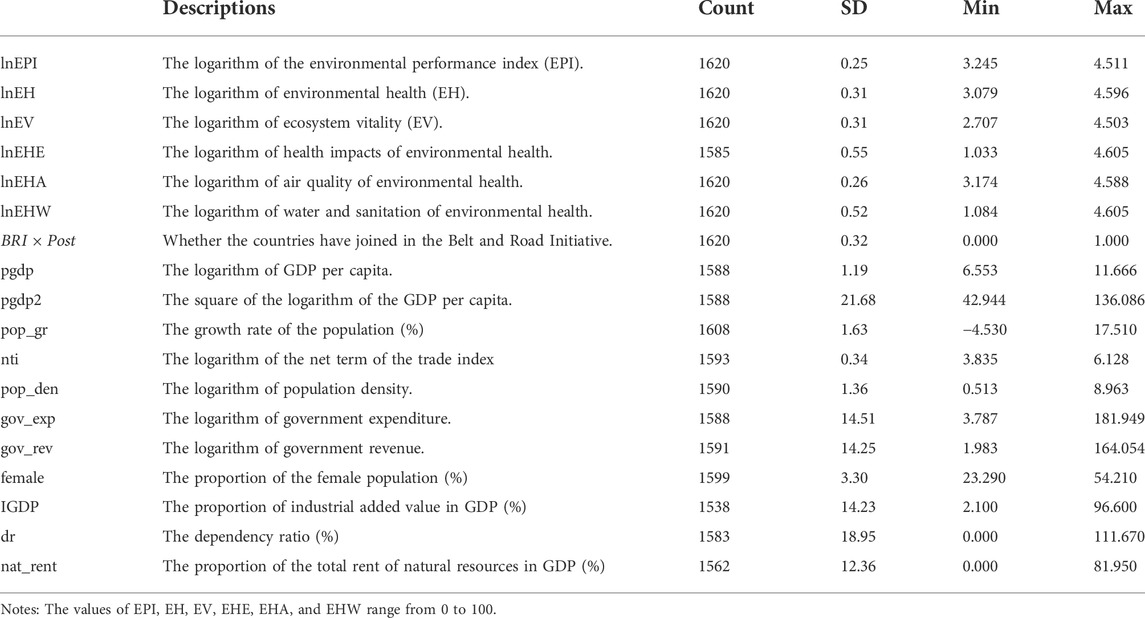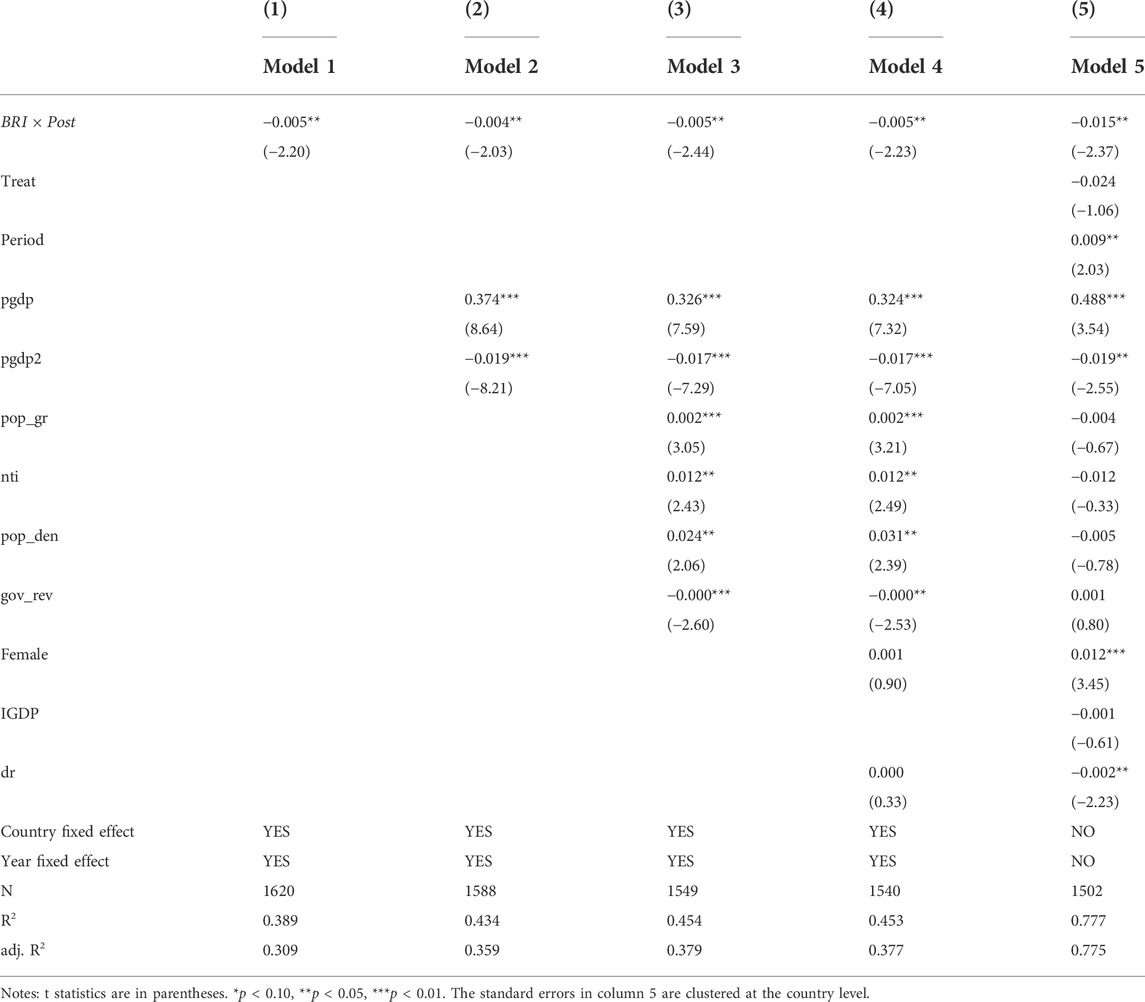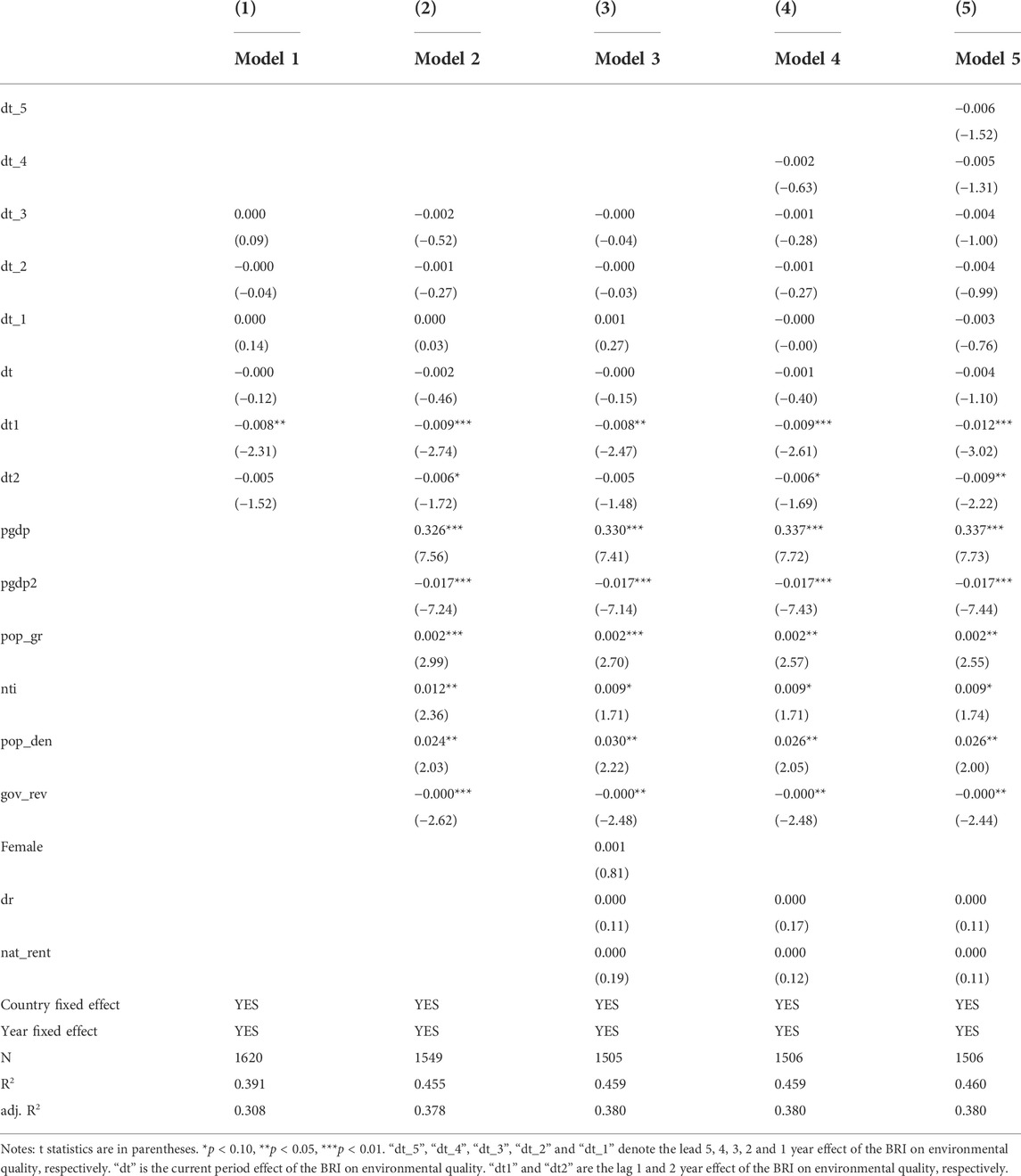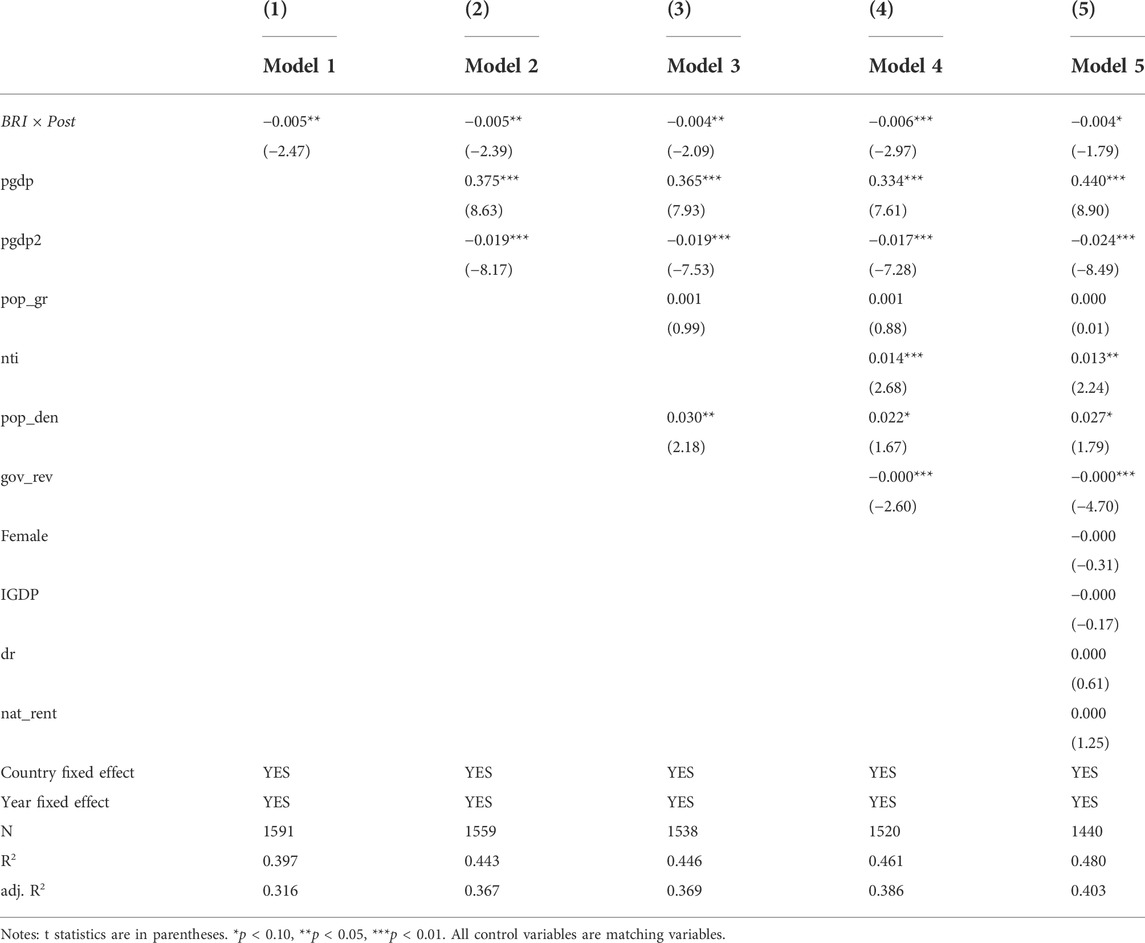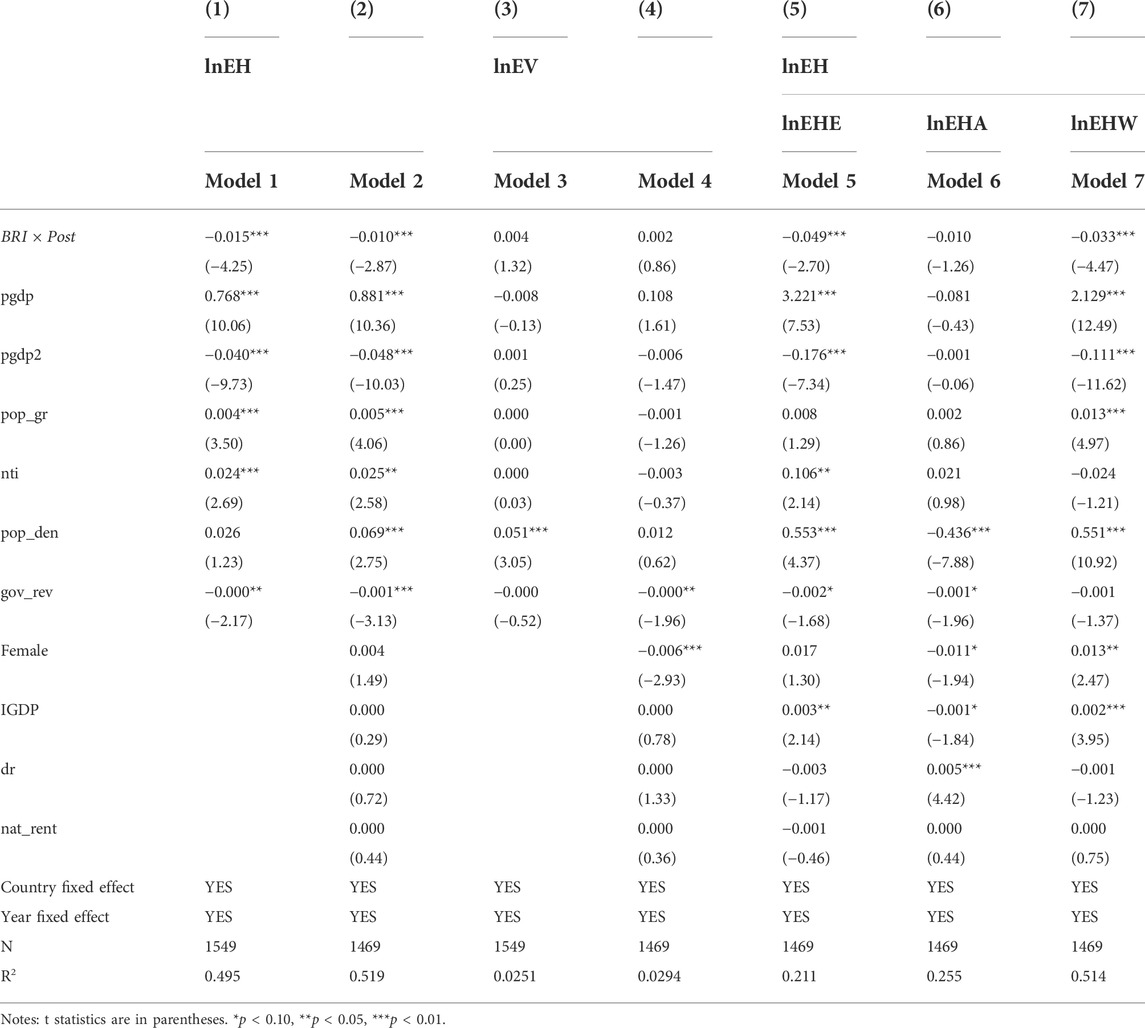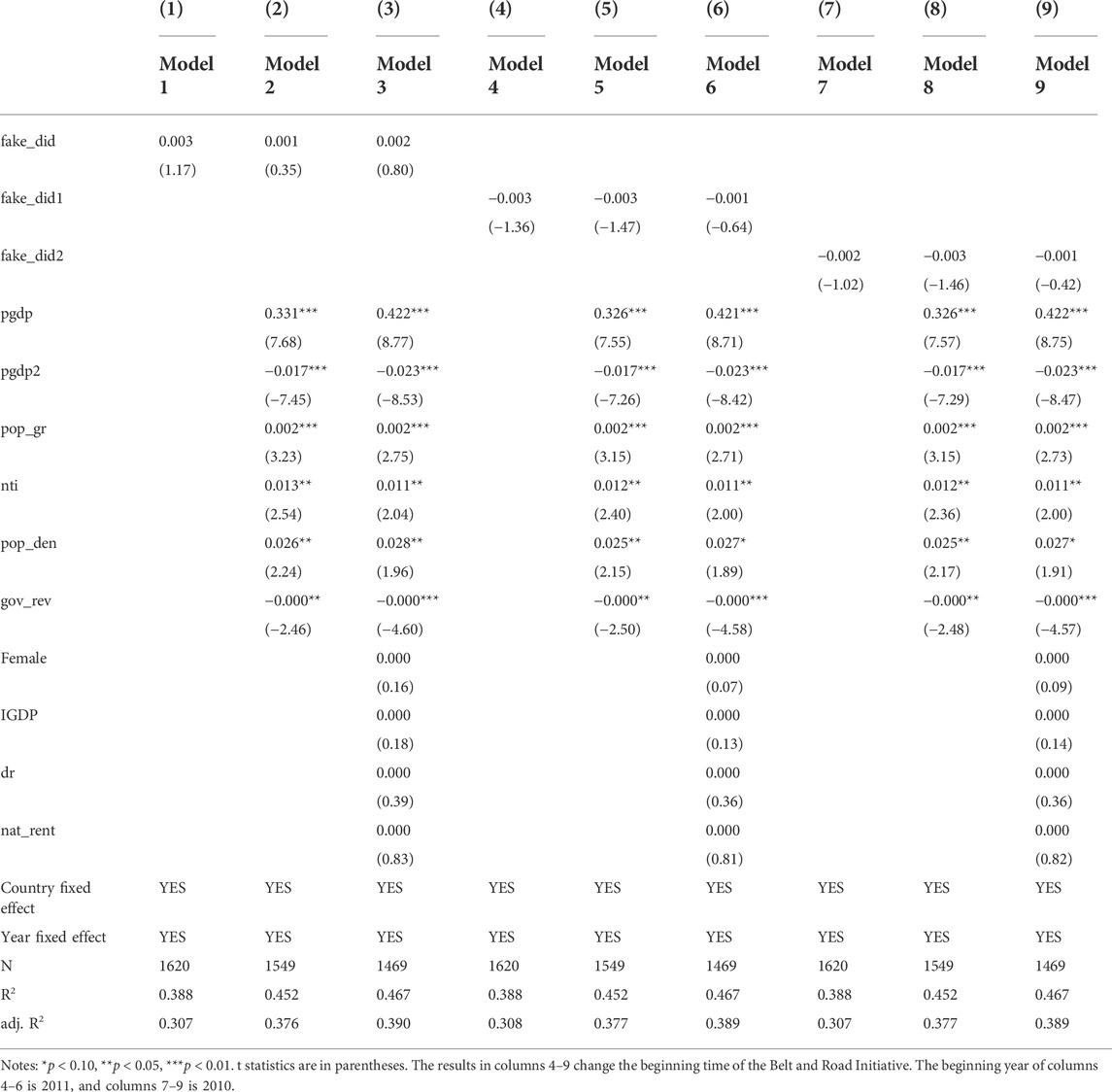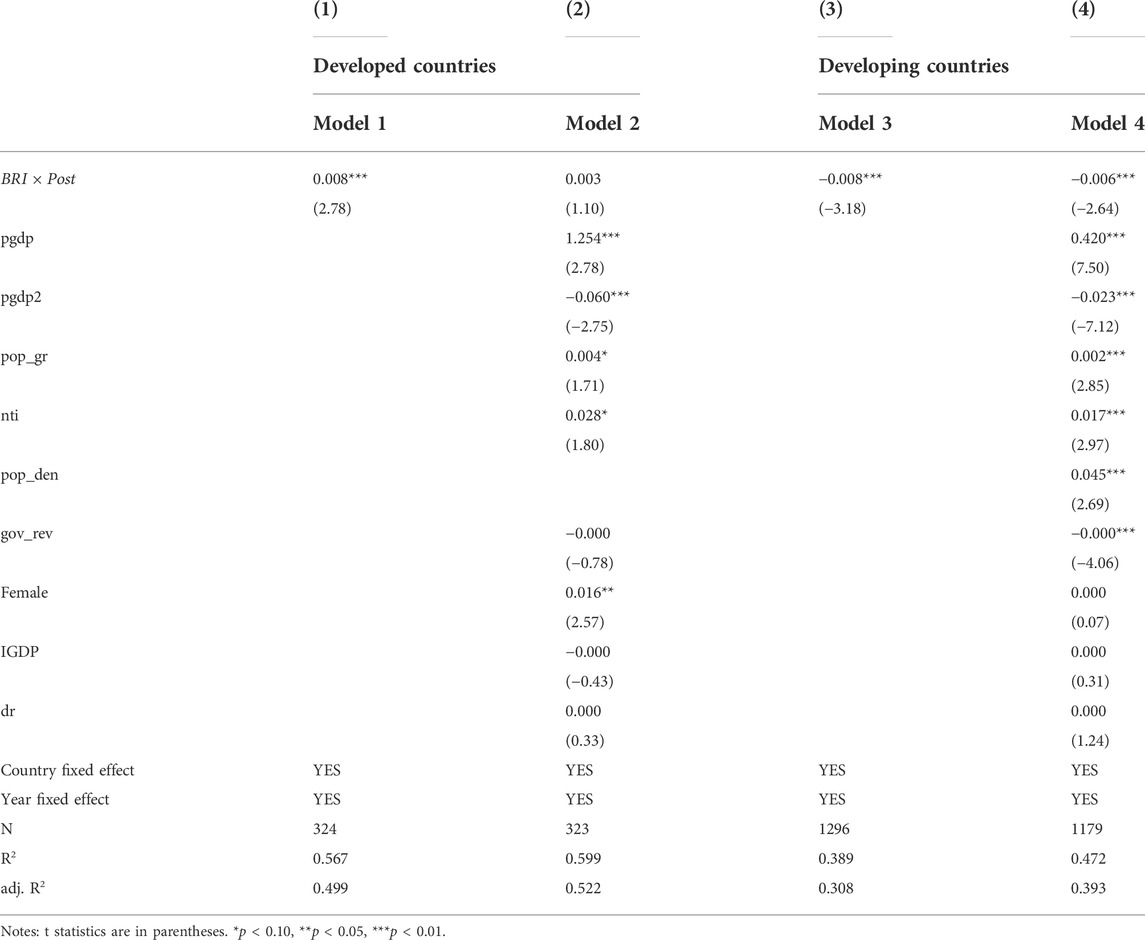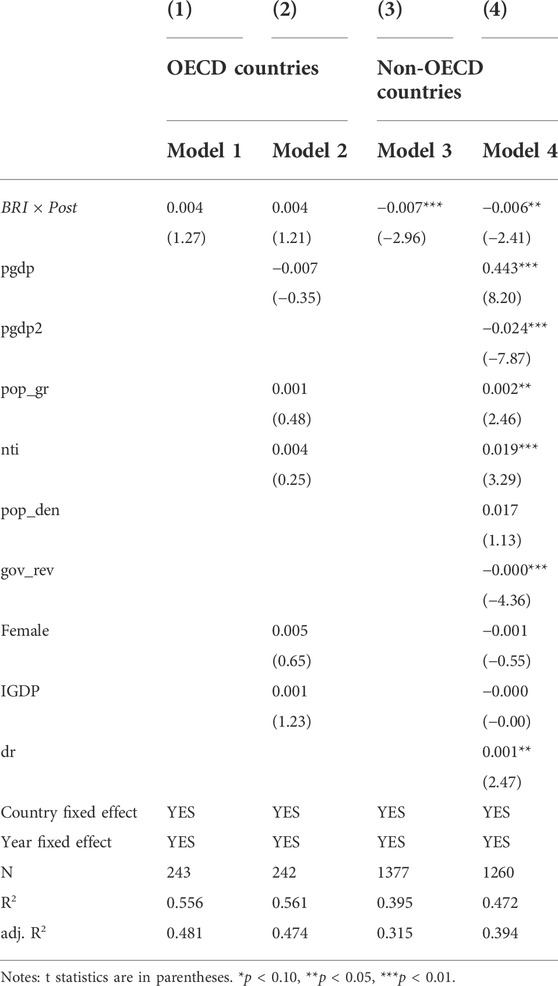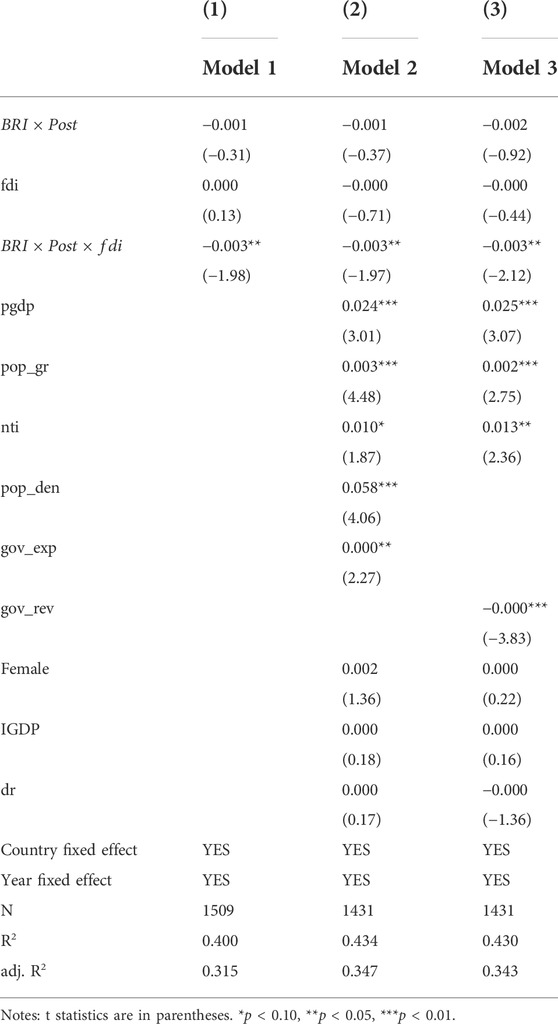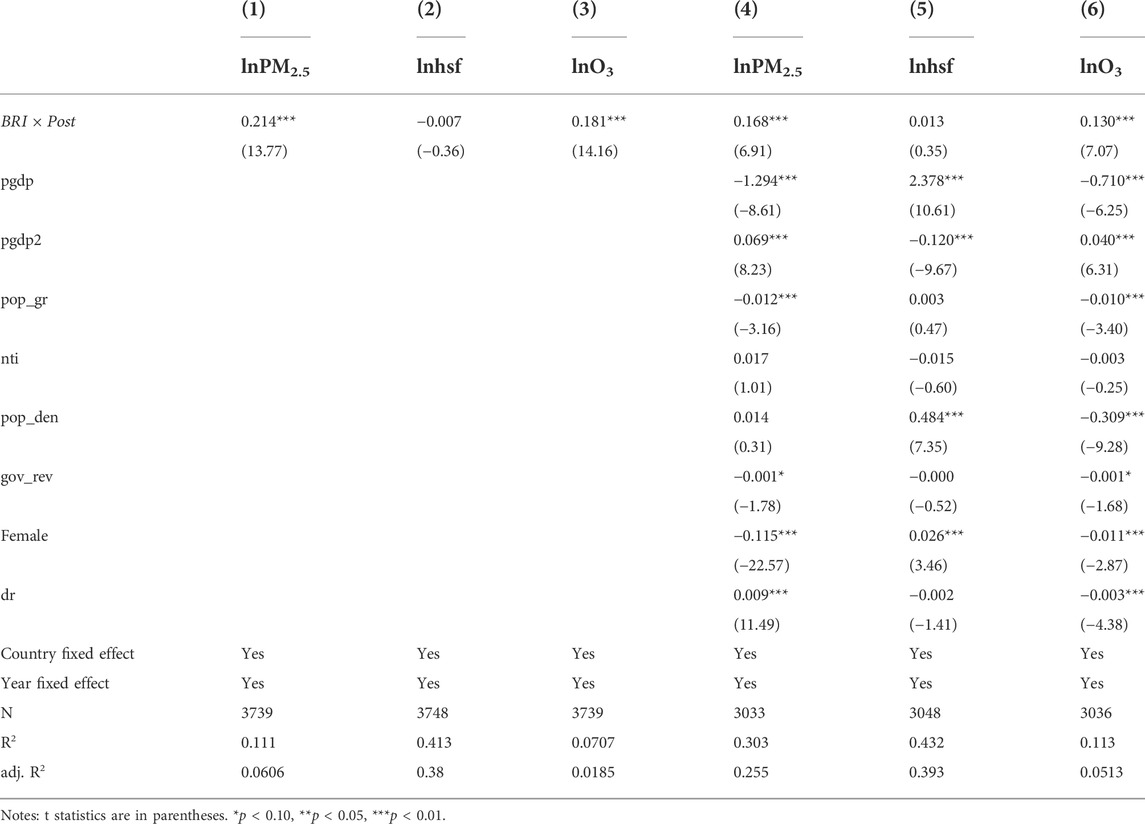- 1School of Business, Hubei University, Wuhan, China
- 2Ant Group Research Institute, Shanghai, China
- 3Research Center of Open Economy, Hubei University, Wuhan, China
China’s Belt and Road Initiative is a significant regional economic cooperation. This paper uses the Belt and Road Initiative (BRI) as a quasi-natural experiment to investigate the impact of regional economic cooperation on environmental quality. Using difference-in-differences (DID) and a series of robustness checks, we find that regional economic cooperation like BRI deteriorates environmental quality in countries along the Belt and Road. The main reason is that the improving effects on environmental quality in the BRI countries are smaller than in the non-BRI countries after the BRI. The ecological impacts of the BRI exist differences in different countries. The results show that the BRI improves environmental quality in South Asia, and Europe and Central Asia. However, the BRI negatively affects environmental quality in East Asia and Pacific, developing and non-OECD countries. We found that, unlike the BRI, the Green BRI improves environmental quality in countries along the Belt and Road. We also discuss the mechanism of the BRI on environmental quality from foreign direct investment (FDI).
1 Introduction
The environmental impacts of globalization have caused some concerns from scholars (Shahbaz et al., 2015; Lv and Xu, 2018; Majeed et al., 2021; Onifade et al., 2021; Usman et al., 2021). Some scholars believed that globalization was significant in cushioning environmental degradation by reducing CO2 emissions (Lv and Xu, 2018; Majeed et al., 2021; Onifade et al., 2021), but some scholars found that globalization deteriorated the environmental quality (Shahbaz et al., 2015; Usman et al., 2021). And some scholars have also found that globalization has no (Nan et al., 2022) or U-shape impacts on the environment (Yang et al., 2019). Hence, there exists an uncertain relationship between globalization and the environment, and it is necessary to investigate the impacts of globalization on the environment.
Regional economic cooperation is a necessary stage in the development of economic globalization. As a representative example of regional economic cooperation, the Belt and Road Initiative (BRI) has received global attention since its implementation in 2013 (Liu and Hao, 2018; Bandiera and Tsiropoulos, 2020; Yuan et al., 2021). Nevertheless, the existing literature focused more on the economic effects of the Belt and Road Initiative (BRI) (Yang et al., 2020; Yuan et al., 2021). As the BRI traverses a diverse range of fragile environments (Deng and Du, 2020; Coenen et al., 2021; Yang and Ni, 2022), scholars and civil society organizations have begun noticing the environmental impacts of the BRI (Coenen et al., 2021). A series of studies investigated green development (Huang and Li, 2020; Xu et al., 2021a; Yang and Ni, 2022) and CO2 emission (You et al., 2019; Mahadevan and Sun, 2020; Muhammad et al., 2020; Wang et al., 2020; Li et al., 2021a; Chen et al., 2021; Wang et al., 2021) in BRI economies, but few concerned the environmental effects of the BRI. This paper uses the BRI to analyze whether regional economic cooperation impacts environmental quality.
China’s Belt and Road Initiative, including the Silk Road Economic Belt and the 21st-Century Maritime Silk Road (Ascensão et al., 2018; Chen et al., 2020a; Huang and Li, 2020; Anwar et al., 2021), is China’s primary strategy strengthening its economic integration with countries in Asia, part Europe, and Africa (Tian et al., 2019; Abban et al., 2020; Bastos, 2020; Bird et al., 2020; Li et al., 2021b; Yuan et al., 2021). Meanwhile, as China implements more stringer environmental regulations (Wang and Lin, 2022), environmental quality in China has made significant improvements. However, this causes some concerns that China possibly shifts its polluting industries and excess capacity into less developed countries (Cai et al., 2018). Hence, some politicians and organizations proposed the China environmental threat theory, which says that China’s BRI investment was mainly driven by the transfer of pollution emissions (Cheng and Qi, 2021). As economic cooperation strengthens, less developed countries will become the pollution heaven of developed countries. Developed countries might invest in polluting industries or shift polluting industries into developing countries and obtain profits from that (Benzerrouk et al., 2021; Caetano et al., 2022). Simultaneously, the report released by World Wildlife Fund showed that the BRI overlapped with over 1700 Important Bird Areas or Key Biodiversity and 46 biodiversity hotspots or Global 200 ecoregions. The BRI possibly impacted the environmental quality in the BRI’s areas (Ascensão et al., 2018). However, fewer existing papers discuss the BRI’s effect on environmental quality. Therefore, measuring the BRI’s environmental impact in countries along the Belt and Road is urgent.
We employ a difference-in-differences (DID) method, which has been applied to evaluate the policy effect by comparing the differences between the two groups (Tian et al., 2019; Crost and Felter, 2020; Ren et al., 2020; Jiang et al., 2021a; Bahar et al., 2021) to estimate the environmental effects of the BRI. Then, to check the robustness of the regression results of DID, this paper uses a series of methods, such as employing alternative explained variables, alternative methods, dynamic effects, placebo tests, etc. Different from existing studies, we discuss the heterogeneous impacts of the BRI on environmental quality from four aspects: geographical regions, economic development, OECD countries or not, and the BRI countries or not, to examine whether the BRI has an improving effect on environmental quality. The BRI increased foreign direct investment (FDI) inflows in countries along the Belt and Road (Jin et al., 2021). Moreover, investment impacted the environmental quality and green development (Mahadevan and Sun, 2020; Benzerrouk et al., 2021; Xu et al., 2021b) according to Pollution Halo Hypothesis and Pollution Haven Hypothesis. Based on those, this paper tries to explain the mechanism of the BRI on environmental quality from FDI and compare the differences in the mechanism among different countries. Finally, this paper investigates the environmental effects of the Green Belt and Road.
The contributions of this paper to the literature are threefold. First, unlike existing studies analyzing the averagely environmental effect of the BRI, we discuss the heterogeneous time effects of the BRI on environmental quality using the method of Wooldridge (2021). And considering that existing papers few discuss the green BRI, this paper especially uses the samples before the green BRI and then studies the net environmental effect of the BRI and the Green BRI. Those enrich the studies on the BRI. Second, this paper expanded the regional heterogeneities of the environmental impact of the BRI. We classify the sample countries according to their geographical region, economic development, OECD or not, and the BRI countries or not to investigate the heterogeneous effects of the BRI on environmental quality in countries along the Belt and Road. Third, this paper enriches the mechanism of the BRI on the environment. Existing papers discuss the effect of the BRI on the environment from environmental regulations and the efficiency of resource allocation, which ignore the importance of FDI. This paper discusses the possible mechanism of the BRI on environmental quality from FDI and compares the mechanism’s differences among different economies.
2 Literature review
2.1 Background of the belt and road initiative
Chinese President Xi Jinping first separately proposed the Silk Road Economic Belt and the 21st-Century Maritime Silk Road (Huang and Li, 2020; Jackson and Shepotylo, 2021; Kong et al., 2021) in September and October 2013. They are officially called the Belt and Road Initiative (Jin et al., 2021). It aims to strengthen China’s economic integration with South-East Asia, Eastern Europe, and Africa (Lall and Lebrand, 2020; Muhammad et al., 2020; Jackson and Shepotylo, 2021; Wang et al., 2021). The BRI proposed by China mainly covered 65 countries in 2013 (Tian et al., 2019; Chen et al., 2020b; Anwar et al., 2021; Yuan et al., 2021). And by 23 March 2022, China has signed more than 200 cooperation documents on the Belt and Road with 149 countries and 32 international organizations1. In addition to economic development, the BRI also encourages green development.
The development of the green Belt and Road began in 2016. Until then, China began to create the green Silk Road and promote environmental cooperation. In 2017, Chinese President Xi Jinping stressed the Green Belt and Road2 in the first Belt and Road Forum for International Cooperation. The Green BRI aims to strengthen cooperation in ecological and environmental protection and build a sound ecosystem to achieve the 2030 Agenda for Sustainable Development (Yang and Yang, 2019; Coenen et al., 2021). Since then, the BRI has officially been framed as green development (Lindberg and Biddulph, 2021), and the countries along the B&R actively deepened the cooperation in green development. By the second Belt and Road Forum for International Cooperation, nearly 50 bilateral and multilateral documents in ecology and environment have been signed by China with other BRI countries and international organizations. On 25 April 2019, the International Coalition for Green Development on the B&R was formally established. The coalition provides a new bridge and link for the cooperation of ecological environment and green development among the BRI countries and regions.
2.2 Literature review
Existing literature focused more on the impact factors of green development in BRI countries. These studies ignored the environmental effect of the BRI from a global perspective. The study reviews the literature on influence factors of green growth in the Belt and Road regions before turning to the environmental effect of the BRI.
Existing studies discussed the impact factors of green development in the BRI countries from trade, economic growth, investment, urbanization, and etc. From the perspective of trade, scholars discussed the impacts of exports, imports, foreign trade, and trade openness on the environment. Some scholars thought foreign trade promoted the green development of the BRI countries (Xu et al., 2021b). However, others believed that trade increased China’s environmental and resource challenges (Tian et al., 2019) and CO2 emissions (Fan et al., 2020). Existing papers investigated the impacts of trade on green development from exports and imports. Exports increased carbon emissions in lower-middle-income countries while decreasing carbon emissions in low-, upper-middle- and high-income countries. Moreover, imports increased carbon emissions in low-income countries but reduced emissions in lower-middle-, upper-middle- and high-income countries (Muhammad et al., 2020). For trade openness, Olivier and Yao (2021) found that trade openness increased the CO2 emission in countries along the Belt and Road. However, Saud et al. (2019a) and Saud et al. (2019b) found that trade openness improved environmental quality. There exists an uncertain relationship between economic growth and the environment. Some scholars found that economic growth had an inverted U-shape effect on CO2 emissions (You et al., 2019; Ahmad et al., 2020). Nevertheless, some scholars thought that economic growth deteriorated the environmental quality (Saud et al., 2019a; Rauf et al., 2020; Shakib et al., 2021; Zhuo and Qamruzzaman, 2021) and accelerated CO2 emissions (Han et al., 2020; Olivier and Yao, 2021) in countries along the Belt and Road. Some scholars analyzed the impact of investment on the environment from green infrastructure investment and FDI. From infrastructure investment, scholars found that increasing green infrastructure investment in energy consumption (Yang and Yang, 2019), FDI (Ahmad et al., 2020; Mahadevan and Sun, 2020), and China’s investment (Li et al., 2021a) improved the environmental quality, in countries along the Belt and Road. However, Muhammad et al. (2020) and Shakib et al. (2021) found that FDI hurts environmental quality by boosting CO2 emissions. On the impacts of urbanization on the environment, scholars obtained different conclusions. Some scholars found that urbanization increased greenhouse gas emissions and deteriorated the environmental quality in BRI countries (Lee et al., 2021; Wu et al., 2021). However, some scholars thought urbanization improved the environmental quality in BRI countries (Saud et al., 2019b). Some scholars thought urbanization had non-linear effects on environment. Urbanization had an inverted U-shape effect on carbon emissions in high-income countries but had U-shape effects on low-, low-middle- and upper-middle-income countries (Muhammad et al., 2020). From energy consumption, scholars found that increasing energy consumption (Rauf et al., 2020; Shakib et al., 2021; Zhuo and Qamruzzaman, 2021), energy intensity, and electricity consumption (Saud et al., 2019a; Saud et al., 2019b; Fang et al., 2020) deteriorated the environmental quality and increased CO2 emissions. But increasing renewable energy consumption reduced CO2 emissions in the BRI economies (Rauf et al., 2020; Anwar et al., 2021; Muhammad et al., 2021). For the impacts of transport on the environment in the BRI economies, scholars found that transport freight deteriorated environmental quality in the BRI countries in the long run (Anwar et al., 2020). But green logistics performance negatively impact environmental quality in the BRI (Li et al., 2021b). Finance and green finance had different impacts on the environment. Financial development deteriorated the environmental quality (Ahmad et al., 2020; Muhammad et al., 2021), but green financing improved environmental consequences (Saud et al., 2019a; Zhuo and Qamruzzaman, 2021). Some papers investigated the impacts of policy on the environment in the BRI economies from fiscal policy, political institutions, and institutional quality. Most scholars found that fiscal policy instruments and effective and fair political institutions reduced CO2 emissions (Ashraf et al., 2021; Muhammad et al., 2021). But scholars believed that the institutional quality increased CO2 emissions and deteriorated the environmental quality in the BRI countries (Muhammad et al., 2021). Scholars discussed the nexus of technology and environment in the BRI countries from innovation and efficiency. They found that technological innovation promoted green development (Xu et al., 2021a), and improvement of pure technical efficiency increased the average value of green total factor productivity (GTFP) in the BRI countries (Chen et al., 2020a).
Additionally, some scholars investigated the changing trend of green development in BRI countries. The BRI countries had a more significant potential reduction in the emission of CO2 (Deng and Du, 2020). But environmental inefficiency loss in the BRI countries was increasing (Chen et al., 2021), and environmental inefficiency had a downward trend in the BRI countries (Yuan et al., 2021). Furthermore, the overall average environmental inefficiency value of GHG emission in the countries along the Belt and Road was caused by energy and environmental variables (Wang et al., 2021). And the carbon emissions and pollution in the BRI economies existed spatial spillover effects (You et al., 2019; Jiang et al., 2021b). Some scholars discussed pollution transfer in BRI countries. Export and import trade transfer to BRI countries increased CO2 emissions (Fan et al., 2020). Cai et al. (2018) found that China became the pollution haven for 22 developed countries and 19 developing countries became the pollution haven for China.
Some scholars used the BRI as a quasi-natural experiment to analyze the environmental effect of the BRI. Cao et al. (2020), using 2005–2017 data, and Yu et al. (2021), employing 2003–2017 data, found that the BRI improved environmental quality in countries along the Belt and Road and China’s cities along the Belt and Road. They believed technological innovation, environmental regulations, and resource allocation efficiency impacted the nexus between the BRI and the environment (Cao et al., 2020; Yu et al., 2021). Jiang et al. (2021a) found that the BRI had a 34.5% energy-saving and 36.4% emission-reduction effect. They found that the technology spillover, the updates of industrial structure, and the promotion of the green trade played the mediating effects of the impacts of BRI on energy saving and carbon emission.
Therefore, the existing literature focuses on the environment and its impact factors on the BRI economies. Even though some scholars discussed the environmental effects of the BRI, the period of these papers covered the Green BRI, and they ignored the net environmental impact of the BRI before the Green BRI and the heterogeneous effects of the BRI on environmental quality. Hence, we analyze the environmental impact of the BRI and its heterogeneous effects from four dimensions. Enriching the literature on the environmental impact of the BRI. We also discuss the possible mechanism of the BRI on environmental quality from FDI inflow and compare the differences in the mechanism in different countries. Finally, we also discuss the impacts of the Green BRI on environmental quality.
3 Data
This paper uses the panel data of 180 countries spanning from 2007 to 20153 to investigate the causal effects of the BRI on environmental quality due to the availability of data. The 180 countries include 64 BRI countries4 and 116 non-BRI countries. We describe these data below before defining the control variables.
3.1 Environmental quality
Referring to Li et al. (2020), we use a comprehensive environmental performance index (EPI) indicator to measure environmental quality. This indicator contains environmental health and ecosystem vitality, including nine issues and more than 20 indicators. The complete methodological details and indicator-level metadata are available at www.epi.yale.edu. We use the latest EPI panel data and sub-indicators of version 20165. The larger the EPI, the better the environmental quality. The value of the EPI and its sub-indicators range from 0 to 100. We use the EPI as the primary measure of the overall environmental quality and employ some sub-indicators of EPI, such as environmental health and ecosystem vitality, as alternative measures for robustness checks. All environmental indicators are taken as logarithms.
3.2 Belt and Road Initiative status
3.3 Control variables
The control variables in this paper include the level of economic development, industrial structure, country size, population growth, population structure, international trade, government actions, and natural resources. 1) Economic development. Economic development is measured by the logarithm of GDP per capita (He and Wang, 2012; Zhou et al., 2019). According to the environmental Kuznets curve (EKC) (Grossman and Krueger, 1991; Grossman and Krueger, 1995), economic growth has an inverted U-shape effect on environmental pollution. The square term of the logarithm of GDP per capita is added to our model. 2) Industrial structure. We measure the industrial structure by using the proportion of industrial added value in GDP. 3) Population density. Referring to He and Wang (2012), Brajer et al. (2011), and Hao et al. (2016), we use the logarithm of population density to measure population density. 4) Population growth. Referring to Ibrahim and Vo (2021), we employ the growth rate of the population to measure population growth. 5) Population structure. We use the proportion of the female population to measure population structure in gender and the dependency ratio to measure population structure in age. 6) International trade. The logarithm of the net term of trade index is used to measure international trade. 7) Government action. We use the logarithms of government revenue and expenditure (Feng et al., 2020; Zhao et al., 2021). 8) Natural resources. The proportion of the total rent of natural resources in GDP is used to measure natural resources. The data sources of control variables are from World Bank and International Monetary Fund (IMF). Table 1 shows the details of the variables in this paper. The correlation coefficients mainly used in this paper are shown in Supplementary Figure SA2.
4 Empirical models
4.1 Main model
We use the difference-in-differences (DID) method combined with a two-way fixed effect of year and country, controlling the time-invariant and time-varying unobserved country characteristics. By calculating the difference between BRI countries and non-BRI countries, the net impact of the BRI on environmental quality is uncovered. The specific model is set as follows.
Where
4.2 Parallel trend test
The premise of the difference-in-differences is that the BRI countries have the same time trend as the non-BRI countries over the same period before implementing the BRI. If the common trend assumption is violated, the DID method does not give a satisfying result (Wang et al., 2019). Therefore, referring to Cai et al. (2016), we construct the following model in Eq. 2 to compare the pre-existing environmental quality trend and confirm the assumption’s validity.
4.3 Heterogeneous time effect
Considering that the treatment effect of the BRI on environmental quality possibly varies by time, we refer to Wooldridge (2021) and construct the model as follows to discuss the heterogeneous time effects of the BRI:
Where
4.4 Moderating effects of foreign direct investment
Existing studies showed that globalization, such as trade agreements and tax agreements, impacted the FDI inflow of member states (Baltagi et al., 2008; Doytch and Uctum, 2016; Luo et al., 2022). And FDI inflow could deteriorate or improve the environment of a host country (Hille et al., 2019; Demena and Afesorgbor, 2020; Udemba and Yalçıntaş, 2021). Hence, FDI has uncertain effects on the BRI on the environment, and it is necessary to investigate the impact of FDI on the nexus between the BRI and the environment. Based on those, we construct the following model to discuss the moderating effect of FDI:
Where
5 Results
5.1 Baseline results
This section aims to estimate the impact of the BRI on environmental quality. The basic regression results are in Table 2. Overall, the coefficients on the “
5.2 Robustness checks
5.2.1 Testing for the pre-existing time trends and expectation effects
To address the concerns of the existing time trends and expectation effects, we use Eq. 2 to estimate all the time lags and lead effects of the BRI on environmental quality. The results are in Table 3. All estimated coefficients are insignificant during the pre-treatment period, indicating no systematic differences in pre-trends across the BRI and non-BRI countries. It supports the assumption of a common trend between the BRI countries and non-BRI countries. The results suggest that the previous time trend does not exist and that expectation effects validate.
5.2.2 Alternative estimate methods
We employ robust standard errors, PSM-DID, synthesis difference in differences (SDID) and instrumental variable method (IV) as alternative methods to test the robustness. First, to reduce the heteroscedasticity effects between groups and autocorrelation within groups, we report the results with robust standard errors in Table 4. Second, considering that there possibly exist some differences between the treatment and control groups, we also use PSM-DID with caliper matching (see Table 5). Third, considering the control and treatment groups possible are not random, we use SDID to estimate the environmental effect of the BRI (see Table 6). Four, we use the IV to solve the endogeneities caused by omitted variables and the bidirectional causal relation between environmental quality and the BRI. Referring to Jin et al. (2021), we construct two instrumental variables of the “
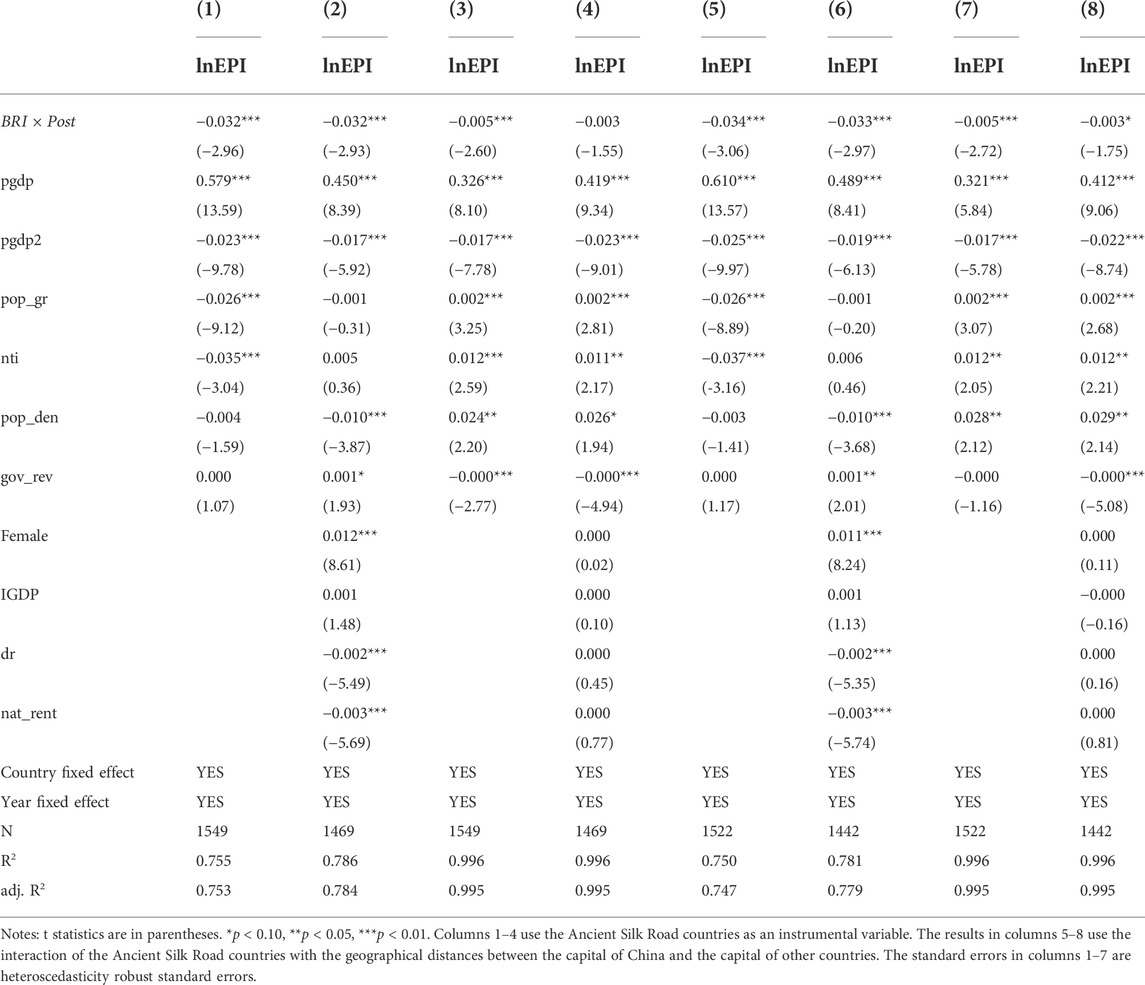
TABLE 7. Effects of the Belt and Road Initiative on environmental quality: Instrumental variable method.
5.2.3 Alternative explained variables
Considering that the environmental performance index (EPI) possibly exists in measurement errors, we employ the sub-indicators of EPI as alternative variables for robustness checks. As EPI ranks countries’ performance on high-priority environmental issues in two areas: protecting human health and ecosystems9, we will discuss the impacts of the BRI on the two areas of EPI and report the regression results in Table 8. The BRI deteriorates environmental health (see columns 1–2) and has no impact on ecosystem vitality (see columns 3–4). Because environmental health contains the environmental risk exposure in health impacts (EHE)10, air quality (EHA)11, and water quality (EHW)12, we regress the “
5.2.4 Heterogeneous time effects
Using Eq. 3, we estimate the heterogeneous time effects of the BRI on environmental quality. The estimated results are in Table 9. The coefficients of “
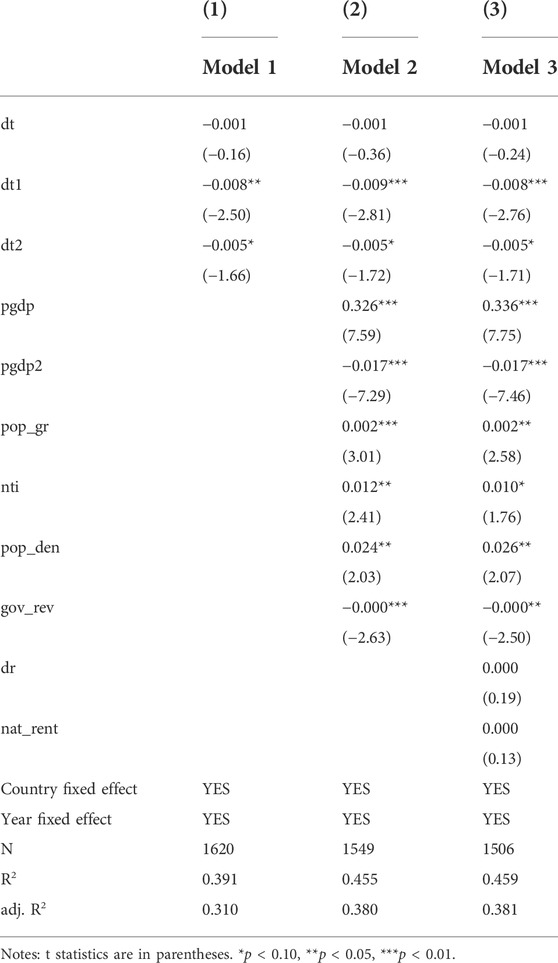
TABLE 9. Effects of the Belt and Road Initiative on environmental quality: Heterogeneous time effects.
5.2.5 Placebo tests
Considering that the results are biased due to the omitted variables at the country level, we conducted the same placebo tests as many other papers (Cai et al., 2016; Wang et al., 2019; Jiang et al., 2021a), randomly assigning the BRI status to countries. The sample is divided into the BRI countries and non-BRI countries according to a ratio of 1:3. The regression results are in columns 1–3 in Table 10. In addition, we also set up two temporal dummy variables for the BRI, 2 years ahead and 3 years ahead, respectively, to construct the pseudo-treatment and control groups (Jiang et al., 2021a). The regression results are in columns 4–6 and 7–9, respectively. The coefficients for fake_did, fake_did1, and fake_did2 are not significant at the 10% level, indicating that the baseline results in Table 2 are robust.
6 Discussion
The above section has shown that the BRI negatively affects environmental quality for countries along the Belt and Road. This section divides the whole samples into sub-samples to test the BRI’s heterogeneous effects and mechanism and investigate the Green BRI’s environmental effects.
6.1 Heterogeneity analysis
6.1.1 Heterogeneous effects of economic-geographical regions
According to the classification of the World Bank, the samples are first divided into four sub-samples: South Asia, Europe and Central Asia, Middle East and North Africa, and East Asia and Pacific, to discuss the heterogeneous effect of the BRI13. The results are in Table 11. The BRI improves the environmental quality in countries along the Belt and Road in South Asia and Europe and Central Asia (see columns 1–4). The BRI has no impact on environmental quality in countries in the Middle East and North Africa (see columns 5–6). And the BRI deteriorates the environmental quality in countries along the Belt and Road in East Asia and the Pacific (see columns 7–8). The possible reason is, the BRI countries in East Asia and the Pacific are at the high-speed development stage, and countries in this stage focus more on economic development and pay less attention to improving the environment. Those might lead to these countries promoting economic growth instead of green development through the BRI, which reduces the improvements in environmental quality in these countries.
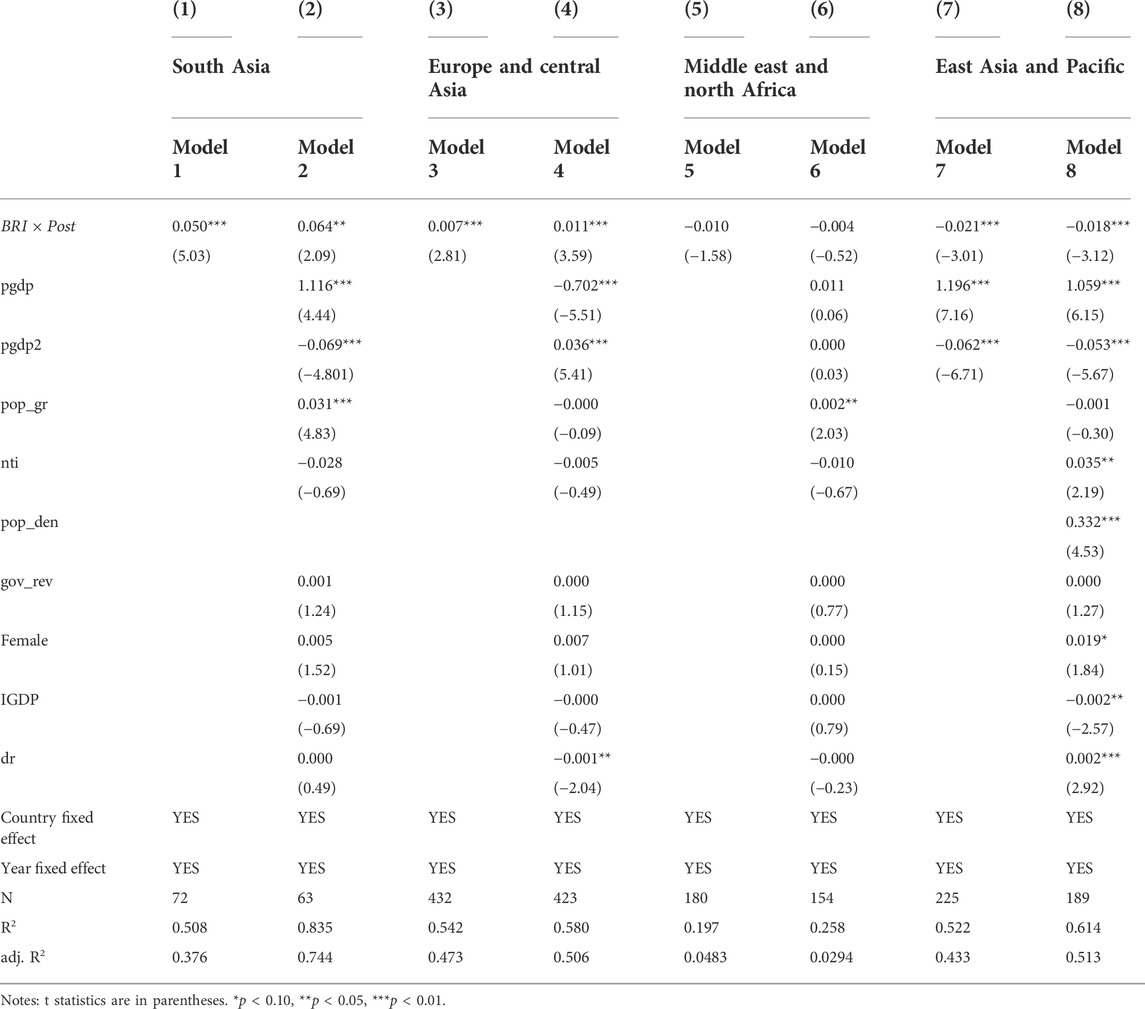
TABLE 11. Effects of the Belt and Road Initiative on environmental quality: Economic-geographical regions.
6.1.2 Heterogeneous effects of economic development
Secondly, the BRI differently impacts green development in developed and developing countries (Huang and Li, 2020). We classify the samples into developed and developing countries according to the stage of economic development (Li et al., 2020) to discuss the heterogeneous effects of the BRI on environmental quality in the two groups. The regression results are in Table 12. The BRI has a positive but not robust impact on environmental quality in developed countries along the Belt and Road (see columns 1–2). But the BRI deteriorates environmental quality in developing countries along the Belt and Road (see columns 3–4). We infer that regional economic cooperation like the BRI possibly causes pollution transfer from developed countries to developing countries. And in pursuit of economic growth, the BRI developing countries are willing to undertake the polluting industries from the BRI developed countries. Hence, the BRI positively correlates environment in the BRI developed countries and deteriorates the environment in the BRI developing countries.
6.1.3 Heterogeneous effects by OECD countries
Thirdly, referring to the list of OECD countries14, the samples are divided into two groups according to whether the countries are OECD countries or not. The regression results are in Table 13. The BRI has no impact on environmental quality for OECD countries along the Belt and Road (see columns 1–2) and deteriorates environmental quality for non-OECD countries along the Belt and Road (see columns 3–4).
6.1.4 Heterogeneous effects by Belt and Road countries
Fourthly, we employ the single-difference method to discuss environmental quality change in the BRI countries and non-BRI countries before and after the BRI. The estimated results are in Table 14. The BRI improves the environmental quality in the BRI countries (see columns 1 and 3) and non-BRI countries (see columns 2 and 4). Especially, we compare EPI differences in BRI countries and non-BRI countries (see Table 15). The results show that EPI differences in the BRI and non-BRI countries are narrowing after 2013 compared with the years before 2013. And the BRI countries have better environmental quality compared with non-BRI countries. Hence, the negative effect of the BRI on environmental quality in countries along the Belt and Road is because the improvement level of environmental quality in the BRI countries is lower than that in the non-BRI countries after the BRI.
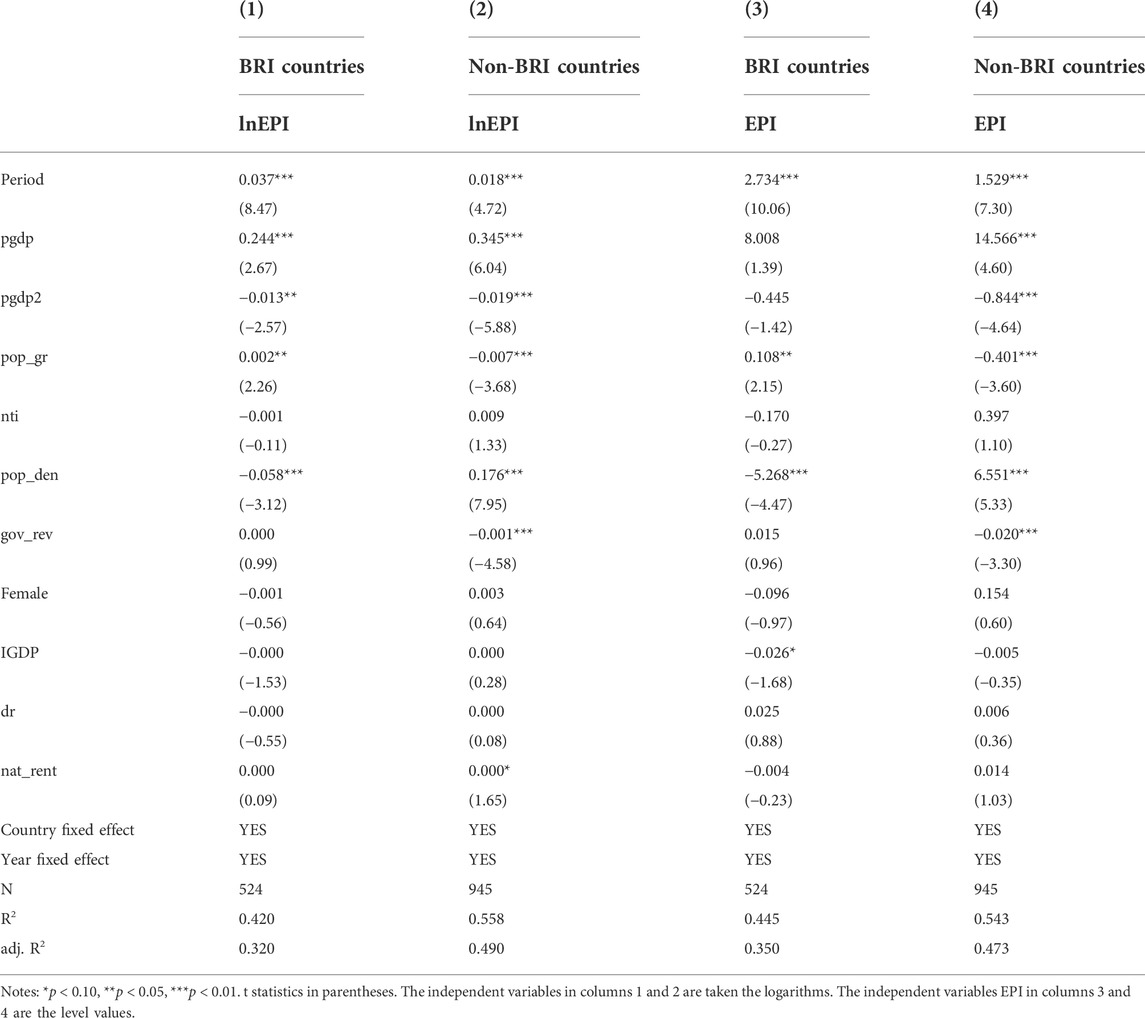
TABLE 14. Effects of the Belt and Road Initiative on environmental quality: The Belt and Road countries or not.

TABLE 15. The differences in environmental performance index between BRI countries and non-BRI countries.
6.2 Mechanism analysis
We have investigated the effects and heterogeneous effects of the BRI on environmental quality in the above sections. This part uses Eq. 4 and discusses the possible mechanism of the BRI on environmental quality from foreign direct investment (FDI). The regression results are in Table 16. The coefficients of the interaction of “
6.3 The environmental effect of the Green Belt and Road Initiative
Using the data before the Green BRI15, we find that the BRI harms environmental quality. Considering that the Green BRI might have different environmental effects, this part uses 179 countries from 2000 to 2020 to analyze this effect. The environmental data are from the EPI (2020). This edition does not publish the panel data of EPI and its two topics but releases the panel data of EPI’s sub-indicators. Considering that air quality has an essential meaning to human life, we use three indicators16: PM2.5 exposure (lnPM2.5), household solid fuels (lnhsf), and Ozone exposure (lnO3) to denote environmental quality. The results are in Table 17. The Green BRI improves air quality in PM2.5 exposure and Ozone exposure but cannot impact household solid fuels.
7 Conclusion
This paper uses panel data from 116 non-BRI economies and 64 BRI economies spanning 2007–2015. Taking the BRI as an example, this paper investigates the impacts of regional economic cooperation on environmental quality using the difference-in-differences method. We adopt a series of methods to test the robust effects of the BRI on environmental quality. We also discuss the heterogeneous impacts and the potential channel of the impact of the BRI on environmental quality and investigate the environmental effect of the Green BRI. We draw the following conclusion.
Firstly, the BRI negatively affects environmental quality in countries along the Belt and Road. And a series of robustness checks support this conclusion. Secondly, the BRI has heterogeneous time effects on environmental quality. The BRI in 2014 and 2015 deteriorated the environmental quality in the BRI countries. However, the BRI cannot significantly impact the environmental quality in the BRI countries in 2013. Thirdly, the regional heterogeneities show that the BRI has different impacts on environmental quality. The BRI improves environmental quality in South Asia and Europe and Central Asia, and the BRI has an improving but not robust effect on environmental quality in developed countries. And the BRI has an insignificant impact on environmental quality in the Middle East and North Africa, and OECD countries. However, the BRI deteriorates the environmental quality in East Asia and Pacific, developing countries, and non-OECD countries. Fourthly, environmental quality in the BRI countries and non-BER countries has been improved after the BRI. But compared with the non-BRI countries, the improving effects of the BRI on environmental quality in countries along the Belt and Road are more minor after the BRI. Hence, the BRI negatively impacts environmental quality in BRI countries. Fifthly, the Green BRI improves the environmental quality in countries along the Belt and Road. Finally, the mechanism analysis shows the deteriorating effect of the BRI on environmental quality increases as FDI increases, but the mechanism exists differences among different countries. The BRI cannot impact environmental quality through FDI in South Asia, East Asia and Pacific, and developed countries. The improving effect of the BRI on environmental quality via FDI exists in countries in Europe and Central Asia, and the BRI has an improving but unsound impact on environmental quality through FDI in OECD countries. However, the BRI deteriorates the environmental quality via FDI in countries in the Middle East and North Africa, and developing countries.
Based on the above conclusions, the following policies can be proposed. Firstly, the BRI should take more green actions to protect the environment. Even though the BRI negatively affects the environment, the green BRI improves the environment. Hence, it is necessary to promote the construction of the Green BRI. Secondly, the countries in East Asia and Pacific should strengthen environmental protection and implement stricter environmental regulations to avoid the harm of the BRI to their environment. Thirdly, the countries along the B&R should be paid more attention to the quality of FDI and introduce clean technology and green FDI to avoid the harm of the BRI to the environment. Especially before FDI inflow, the countries should consider the types of FDI, avoid the energy-intensive and pollution-intensive industries inflow, and promote green investment in the Belt and Road.
Some limitations exist in this paper. Firstly, we focus more on the environmental effects of the BRI. It is worth evaluating the impact and mechanism of the green BRI on the environment. The green BRI is more important to the environmental development of the BRI countries. Secondly, we only discuss the impact of FDI on the relationship between the BRI and environment. The further research could examine other channels, such as technology upgrading and environmental regulations, of the effect of the BRI on the environment.
Data availability statement
The datasets generated during and analyzed during the current study are available from the first author on reasonable request.
Author contributions
BL: methodology, software, formal analysis, data curation, writng—original draft, writing—review and edit, visualization, validation; JH: data curation, writing—original draft; GC: writing—review and edit, validation; DX: supervision, funding acquisition; SC: supervision, funding acquisition.
Funding
This study was funded by the Key Program of the National Social Science Fund (Grant No. 19AJL016); the General Program of the National Social Science Fund (Grant No. 20BJL140); and the Youth Program of National Social Science (Grant No. 21CJL021).
Acknowledgments
This is a short text to acknowledge the recommendations of the two reviewers and editor. All errors are our own.
Conflict of interest
The authors declare that the research was conducted in the absence of any commercial or financial relationships that could be construed as a potential conflict of interest.
Publisher’s note
All claims expressed in this article are solely those of the authors and do not necessarily represent those of their affiliated organizations, or those of the publisher, the editors and the reviewers. Any product that may be evaluated in this article, or claim that may be made by its manufacturer, is not guaranteed or endorsed by the publisher.
Supplementary material
The Supplementary Material for this article can be found online at: https://www.frontiersin.org/articles/10.3389/fenvs.2022.1020502/full#supplementary-material
Abbreviations
BRI, Belt and Road Initiative; DID, difference-in-differences; FDI, foreign direct investment; B&R, the Belt and Road; MENA, Middle East and North Africa; OECD, Organization for Economic Cooperation and Development; GTFP, green total factor productivity; GHG, greenhouse gas; EPI, environmental performance index; GDP, gross domestic product; EKC, environmental Kuznets curve; IMF, International Monetary Fund; EQ, environmental quality; EH, environmental health; EV, ecosystem vitality; EHE, health impacts of environmental health; EHA, air quality of environmental health; EHW, water and sanitation of environmental health; PSM, propensity score matching; SDID, synthesis difference in differences; IMF, International Monetary Fund.
Footnotes
1https://www.yidaiyilu.gov.cn/xwzx/roll/77298.htm.
2The Green Belt and Road refers to the concept of green, environmental protection, and low carbon in constructing the Belt and Road. It aims to improve the industrialization development capacity, resource utilization, and environmental carrying capacity and promote the balanced development of the economy, environment, and society.
3Because the latest version of environmental quality data only contains 2007–2015, we have to use the period.
4The BRI countries are shown in Supplementary Figure SA1. Due to the missing data on environmental quality, Palestine is not included in the samples.
5This version contains 180 countries from 2007 to 2015.
6See http://www.gdqy.gov.cn/xxgk/zzjg/zfjg/qysswj/tzgga/content/post_533138.html.
7The Ancient Silk Road includes the nations reached by Zhang Qian in Han Dynasty and the countries reached by Zheng He in Ming Dynasty.
8The geographical distances are between the capitals in the two countries from the CEPII database. The detailed website is http://www.cepii.fr/CEPII/en/bdd_modele/bdd.asp.
9The protection of human health reflects the objective of environmental health (EH), and the protection of ecosystems reflects ecosystem vitality.
10Human health includes water and air pollution risks to human health.
11Air quality includes exposure to PM2.5, NO2, and a percentage of the population burning solid fuel indoors.
12Water quality tracks the portion of a population with access to safe drinking water and sanitation infrastructure.
13The BRI countries are not in North America, Sub-Saharan Africa, and Latin America and the Caribbean. Hence, we will not discuss the samples in these regions.
15We use 2017 as the implementation time of the Green Belt and Road. For Post, 2017 and the years after 2017 take 1 and 0 otherwise. For the Green Belt and Road Initiative, the treatment group and control group are the same as the BRI.
16The range of EPI is from 0 to 100. The larger the value, the better the air quality.
References
Abban, O. J., Wu, J., and Mensah, I. A. (2020). Analysis on the nexus amid CO2 emissions, energy intensity, economic growth, and foreign direct investment in belt and road economies: Does the level of income matter? Environ. Sci. Pollut. Res. 27 (10), 11387–11402. doi:10.1007/s11356-020-07685-9
Ahmad, M., Jiang, P., Majeed, A., and Raza, M. Y. (2020). Does financial development and foreign direct investment improve environmental quality? Evidence from belt and road countries. Environ. Sci. Pollut. Res. 27 (19), 23586–23601. doi:10.1007/s11356-020-08748-7
Anwar, A., Ahmad, N., and Madni, G. R. (2020). Industrialization, freight transport and environmental quality: Evidence from belt and road initiative economies. Environ. Sci. Pollut. Res. 27 (7), 7053–7070. doi:10.1007/s11356-019-07255-8
Anwar, M. A., Nasreen, S., and Tiwari, A. K. (2021). Forestation, renewable energy and environmental quality: Empirical evidence from Belt and Road Initiative economies. J. Environ. Manag. 291, 112684. doi:10.1016/j.jenvman.2021.112684
Ascensão, F., Fahrig, L., Clevenger, A. P., Corlett, R. T., Jaeger, J. A. G., Laurance, W. F., et al. (2018). Environmental challenges for the belt and road initiative. Nat. Sustain. 1 (5), 206–209. doi:10.1038/s41893-018-0059-3
Ashraf, J., Luo, L., and Anser, M. K. (2021). Do BRI policy and institutional quality influence economic growth and environmental quality? An empirical analysis from South asian countries affiliated with the belt and road initiative. Environ. Sci. Pollut. Res. 29, 8438–8451. doi:10.1007/s11356-021-16330-y
Bahar, D., Ibáñez, A. M., and Rozo, S. V. (2021). Give me your tired and your poor: Impact of a large-scale amnesty program for undocumented refugees. J. Dev. Econ. 151, 102652. doi:10.1016/j.jdeveco.2021.102652
Baltagi, B. H., Egger, P., and Pfaffermayr, M. (2008). Estimating regional trade agreement effects on FDI in an interdependent world. J. Econ. 145 (1), 194–208. doi:10.1016/j.jeconom.2008.05.017
Bandiera, L., and Tsiropoulos, V. (2020). A framework to assess debt sustainability under the belt and road initiative. J. Dev. Econ. 146, 102495. doi:10.1016/j.jdeveco.2020.102495
Bastos, P. (2020). Exposure of belt and road economies to China trade shocks. J. Dev. Econ. 145, 102474. doi:10.1016/j.jdeveco.2020.102474
Benzerrouk, Z., Abid, M., and Sekrafi, H. (2021). Pollution haven or halo effect? A comparative analysis of developing and developed countries. Energy Rep. 7, 4862–4871. doi:10.1016/j.egyr.2021.07.076
Bird, J., Lebrand, M., and Venables, A. J. (2020). The belt and road initiative: Reshaping economic geography in central Asia? J. Dev. Econ. 144, 102441. doi:10.1016/j.jdeveco.2020.102441
Brajer, V., Mead, R. W., and Xiao, F. (2011). Searching for an environmental Kuznets curve in China's air pollution. China Econ. Rev. 22 (3), 383–397. doi:10.1016/j.chieco.2011.05.001
Caetano, R. V., Marques, A. C., Afonso, T. L., and Vieira, I. (2022). A sectoral analysis of the role of Foreign Direct Investment in pollution and energy transition in OECD countries. J. Environ. Manag. 302, 114018. doi:10.1016/j.jenvman.2021.114018
Cai, X., Lu, Y., Wu, M., and Yu, L. (2016). Does environmental regulation drive away inbound foreign direct investment? Evidence from a quasi-natural experiment in China. J. Dev. Econ. 123, 73–85. doi:10.1016/j.jdeveco.2016.08.003
Cai, X., Che, X., Zhu, B., Zhao, J., and Xie, R. (2018). Will developing countries become pollution havens for developed countries? An empirical investigation in the belt and road. J. Clean. Prod. 198, 624–632. doi:10.1016/j.jclepro.2018.06.291
Cao, X., Teng, C., and Jijun, Z. (2020). Impact of the Belt and Road Initiative on environmental quality in countries along the routes. China Popul. Resour. Environ. 30 (12), 116–124. doi:10.12062/cpre.20200928
Chen, Y., Liu, S., Wu, H., Zhang, X., and Zhou, Q. (2020a). How can Belt and Road countries contribute to glocal low-carbon development? J. Clean. Prod. 256, 120717. doi:10.1016/j.jclepro.2020.120717
Chen, Z., Wang, W., Li, F., and Zhao, W. (2020b). Congestion assessment for the Belt and Road countries considering carbon emission reduction. J. Clean. Prod. 242, 118405. doi:10.1016/j.jclepro.2019.118405
Chen, Z., Yan, T., Zhao, W., and Ni, G. (2021). Capacity utilization loss of the Belt and Road countries incorporating carbon emission reduction and the impacts of China’s OFDI. J. Clean. Prod. 280, 123926. doi:10.1016/j.jclepro.2020.123926
Cheng, S., and Qi, S. (2021). The potential for China's outward foreign direct investment and its determinants: A comparative study of carbon-intensive and non-carbon-intensive sectors along the belt and road. J. Environ. Manag. 282, 111960. doi:10.1016/j.jenvman.2021.111960
Coenen, J., Bager, S., Meyfroidt, P., Newig, J., and Challies, E. (2021). Environmental governance of China's belt and road initiative. Env. Pol. Gov. 31 (1), 3–17. doi:10.1002/eet.1901
Crost, B., and Felter, J. H. (2020). Extractive resource policy and civil conflict: Evidence from mining reform in the Philippines. J. Dev. Econ. 144, 102443. doi:10.1016/j.jdeveco.2020.102443
Demena, B. A., and Afesorgbor, S. K. (2020). The effect of FDI on environmental emissions: Evidence from a meta-analysis. Energy policy 138 (111192), 111192. doi:10.1016/j.enpol.2019.111192
Deng, X., and Du, L. (2020). Estimating the environmental efficiency, productivity, and shadow price of carbon dioxide emissions for the Belt and Road Initiative countries. J. Clean. Prod. 277, 123808. doi:10.1016/j.jclepro.2020.123808
Doytch, N., and Uctum, M. (2016). Globalization and the environmental impact of sectoral FDI. Econ. Syst. 40 (4), 582–594. doi:10.1016/j.ecosys.2016.02.005
Fan, J., Dong, Y., and Zhang, X. (2020). How does “the Belt and Road” and the Sino-US trade conflict affect global and Chinese CO2 emissions? Environ. Sci. Pollut. Res. 27 (31), 38715–38731. doi:10.1007/s11356-020-09935-2
Fang, K., Wang, T., He, J., Wang, T., Xie, X., Tang, Y., et al. (2020). The distribution and drivers of PM2.5 in a rapidly urbanizing region: The Belt and Road Initiative in focus. Sci. Total Environ. 716, 137010. doi:10.1016/j.scitotenv.2020.137010
Feng, T., Du, H., Lin, Z., and Zuo, J. (2020). Spatial spillover effects of environmental regulations on air pollution: Evidence from urban agglomerations in China. J. Environ. Manag. 272, 110998. doi:10.1016/j.jenvman.2020.110998
Grossman, G. M., and Krueger, A. B. (1995). Economic growth and the environment. Q. J. Econ. 110, 353–377. doi:10.2307/2118443
Han, M., Lao, J., Yao, Q., Zhang, B., and Meng, J. (2020). Carbon inequality and economic development across the Belt and Road regions. J. Environ. Manage. 262, 110250. doi:10.1016/j.jenvman.2020.110250
Hao, Y., Chen, H., and Zhang, Q. (2016). Will income inequality affect environmental quality? Analysis based on China's provincial panel data. Ecol. Indic. 67, 533–542. doi:10.1016/j.ecolind.2016.03.025
He, J., and Wang, H. (2012). Economic structure, development policy and environmental quality: An empirical analysis of environmental Kuznets curves with Chinese municipal data. Ecol. Econ. 76, 49–59. doi:10.1016/j.ecolecon.2012.01.014
Hille, E., Shahbaz, M., and Moosa, I. (2019). The impact of fdi on regional air pollution in the republic of Korea: A way ahead to achieve the green growth strategy? Energy Econ. 81, 308–326. doi:10.1016/j.eneco.2019.04.004.6
Huang, M., and Li, S. (2020). The analysis of the impact of the Belt and Road initiative on the green development of participating countries. Sci. Total Environ. 722, 137869. doi:10.1016/j.scitotenv.2020.137869
Ibrahim, M., and Vo, X. V. (2021). Exploring the relationships among innovation, financial sector development and environmental pollution in selected industrialized countries. J. Environ. Manag. 284, 112057. doi:10.1016/j.jenvman.2021.112057
Jackson, K., and Shepotylo, O. (2021). Belt and road: The China dream? China Econ. Rev. 67, 101604. doi:10.1016/j.chieco.2021.101604
Jiang, Q., Ma, X., and Wang, Y. (2021a). How does the one belt one road initiative affect the green economic growth? Energy Econ. 101, 105429. doi:10.1016/j.eneco.2021.105429
Jiang, L., Zhou, H., He, S., Cui, Y., and Wang, J. (2021b). Identifying the driving factors of NO2 pollution of one belt one road countries: Satellite observation technique and dynamic spatial panel data analysis. Environ. Sci. Pollut. Res. 28 (16), 20393–20407. doi:10.1007/s11356-020-12113-z
Jin, G., Shen, K., and Jiang, Y. (2021). Does the Belt and Road Initiative cause more troubled Chinese overseas investments? Int. Rev. Econ. finance 72, 217–232. doi:10.1016/j.iref.2020.11.016
Kong, Q., Chen, A., Shen, C., and Wong, Z. (2021). Has the Belt and Road Initiative improved the quality of economic growth in China's cities? Int. Rev. Econ. Finance 76, 870–883. doi:10.1016/j.iref.2021.07.001
Lall, S. V., and Lebrand, M. (2020). Who wins, who loses? Understanding the spatially differentiated effects of the belt and road initiative. J. Dev. Econ. 146, 102496. doi:10.1016/j.jdeveco.2020.102496
Lee, H. S., Arestis, P., Chong, S. C., Yap, S., and Sia, B. K. (2021). The heterogeneous effects of urbanisation and institutional quality on greenhouse gas emissions in Belt and Road Initiative countries. Environ. Sci. Pollut. Res. 29, 1087–1105. doi:10.1007/s11356-021-15699-0
Li, B., Cheng, S., and Xiao, D. (2020). The impacts of environmental pollution and brain drain on income inequality. China Econ. Rev. 62, 101481. doi:10.1016/j.chieco.2020.101481
Li, X., Liu, C., Wang, F., Ge, Q., and Hao, Z. (2021a). The effect of Chinese investment on reducing CO2 emission for the Belt and Road countries. J. Clean. Prod. 288, 125125. doi:10.1016/j.jclepro.2020.125125
Li, X., Sohail, S., Majeed, M. T., and Ahmad, W. (2021b). Green logistics, economic growth, and environmental quality: Evidence from one belt and road initiative economies. Environ. Sci. Pollut. Res. Int. 28 (24), 30664–30674. doi:10.1007/s11356-021-12839-4
Lindberg, J., and Biddulph, R. (2021). China’s belt and road initiative: The need for livelihood-inclusive stories. Geoforum. Geoforum 121, 138–141. doi:10.1016/j.geoforum.2021.02.015
Liu, Y., and Hao, Y. (2018). The dynamic links between CO2 emissions, energy consumption and economic development in the countries along “the Belt and Road”. Sci. Total Environ. 645, 674–683. doi:10.1016/j.scitotenv.2018.07.062
Luo, C., Luo, Q., and Zeng, S. (2022). Bilateral tax agreement and FDI inflows: Evidence from Hong Kong investment in the Mainland China. China Econ. Rev. 73, 101788. doi:10.1016/j.chieco.2022.101788
Lv, Z., and Xu, T. (2018). Is economic globalization good or bad for the environmental quality? New evidence from dynamic heterogeneous panel models. Technol. Forecast. Soc. Change 137, 340–343. doi:10.1016/j.techfore.2018.08.004
Mahadevan, R., and Sun, Y. (2020). Effects of foreign direct investment on carbon emissions: Evidence from China and its Belt and Road countries. J. Environ. Manage. 276, 111321. doi:10.1016/j.jenvman.2020.111321
Majeed, A., Wang, L., Zhang, X., Muniba, , , and Kirikkaleli, D. (2021). Modeling the dynamic links among natural resources, economic globalization, disaggregated energy consumption, and environmental quality: Fresh evidence from GCC economies. Resour. policy 73, 102204. doi:10.1016/j.resourpol.2021.102204
Muhammad, S., Long, X., Salman, M., and Dauda, L. (2020). Effect of urbanization and international trade on CO2 emissions across 65 belt and road initiative countries. Energy 196, 117102. doi:10.1016/j.energy.2020.117102
Muhammad, S., Xu, D., Muhammad, Z. M., and Atta, U. (2021). Exploring the dynamic relationship between financial development, renewable energy, and carbon emissions: A new evidence from belt and road countries. Environ. Sci. Pollut. Res. 29, 14930–14947. doi:10.1007/s11356-021-16641-0
Nan, S., Huo, Y., You, W., and Guo, Y. (2022). Globalization spatial spillover effects and carbon emissions: What is the role of economic complexity? Energy Econ. 112, 106184. doi:10.1016/j.eneco.2022.106184
Olivier, J. A., and Yao, H. (2021). What initiates carbon dioxide emissions along the belt and road initiative? An insight from a dynamic heterogeneous panel data analysis based on incarnated carbon panel. Environ. Sci. Pollut. Res. 28 (45), 64516–64535. doi:10.1007/s11356-021-14779-5
Onifade, S. T., Gyamfi, B. A., Haouas, I., and Bekun, F. V. (2021). Re-examining the roles of economic globalization and natural resources consequences on environmental degradation in E7 economies: Are human capital and urbanization essential components? Resour. Policy 74, 102435. doi:10.1016/j.resourpol.2021.102435
Rauf, A., Liu, X., Amin, W., Rehman, O. U., Li, J., Ahmad, F., et al. (2020). Does sustainable growth, energy consumption and environment challenges matter for belt and road initiative feat? A novel empirical investigation. J. Clean. Prod. 262, 121344. doi:10.1016/j.jclepro.2020.121344
Ren, S., Liu, D., Li, B., Wang, Y., and Chen, X. (2020). Does emissions trading affect labor demand? Evidence from the mining and manufacturing industries in China. J. Environ. Manage. 254, 109789. doi:10.1016/j.jenvman.2019.109789
Saud, S., Chen, S., Danish, , , and Haseeb, A. (2019a). Impact of financial development and economic growth on environmental quality: An empirical analysis from belt and road initiative (BRI) countries. Environ. Sci. Pollut. Res. 26 (3), 2253–2269. doi:10.1007/s11356-018-3688-1
Saud, S., Chen, S., Haseeb, A., Khan, K., and Imran, M. (2019b). The nexus between financial development, income level, and environment in central and eastern European countries: A perspective on belt and road initiative. Environ. Sci. Pollut. Res. 26 (16), 16053–16075. doi:10.1007/s11356-019-05004-5
Shahbaz, M., Mallick, H., Mahalik, M. K., and Loganathan, N. (2015). Does globalization impede environmental quality in India? Ecol. Indic. 52, 379–393. doi:10.1016/j.ecolind.2014.12.025
Shakib, M., Yumei, H., Rauf, A., Alam, M., Murshed, M., and Mahmood, H. (2021). Revisiting the energy-economy-environment relationships for attaining environmental sustainability: Evidence from belt and road initiative countries. Environ. Sci. Pollut. Res. 29, 3808–3825. doi:10.1007/s11356-021-15860-9
Tian, X., Hu, Y., Yin, H., Geng, Y., and Bleischwitz, R. (2019). Trade impacts of China’s Belt and Road Initiative: From resource and environmental perspectives. Resour. Conservation Recycl. 150, 104430. doi:10.1016/j.resconrec.2019.104430
Udemba, E. N., and Yalçıntaş, S. (2021). Interacting force of foreign direct invest (fdi), natural resource and economic growth in determining environmental performance: A nonlinear autoregressive distributed lag (nardl) approach. Resour. policy 73, 102168. doi:10.1016/j.resourpol.2021.102168
Usman, M., Jahanger, A., Makhdum, M. S. A., Balsalobre-Lorente, D., and Bashir, A. (2021). How do financial development, energy consumption, natural resources, and globalization affect arctic countries' economic growth and environmental quality? An advanced panel data simulation. Energy 241, 122515. doi:10.1016/j.energy.2021.122515
Wang, C., and Lin, Y. (2022). Does bargaining power mitigate the relationship between environmental regulation and firm performance? Evidence from China. J. Clean. Prod. 331, 129859. doi:10.1016/j.jclepro.2021.129859
Wang, K., Yin, H., and Chen, Y. (2019). The effect of environmental regulation on air quality: A study of new ambient air quality standards in China. J. Clean. Prod. 215, 268–279. doi:10.1016/j.jclepro.2019.01.061
Wang, C., Wood, J., Wang, Y., Geng, X., and Long, X. (2020). CO2 emission in transportation sector across 51 countries along the Belt and Road from 2000 to 2014. J. Clean. Prod. 266, 122000. doi:10.1016/j.jclepro.2020.122000
Wang, C., Miao, Z., Chen, X., and Cheng, Y. (2021). Factors affecting changes of greenhouse gas emissions in Belt and Road countries. Renew. Sustain. Energy Rev. 147, 111220. doi:10.1016/j.rser.2021.111220
Wooldridge, J. M. (2021). Two-way fixed effects, the two-way mundlak regression, and difference-in-differences estimators.
Wu, J., Abban, O. J., Boadi, A. D., Haris, M., Ocran, P., and Addo, A. A. (2021). Exploring the relationships among CO2 emissions, urbanization, economic growth, economic structure, energy consumption, and trade along the BRI based on income classification. Energy Ecol. Environ. 6 (3), 213–231. doi:10.1007/s40974-020-00176-0
Xu, Y., Dong, B., and Chen, Z. (2021a). Can foreign trade and technological innovation affect green development: Evidence from countries along the belt and road. Econ. change Restruct. 55, 1063. doi:10.1007/s10644-021-09337-5
Xu, C., Zhao, W., Zhang, M., and Cheng, B. (2021b). Pollution haven or halo? The role of the energy transition in the impact of FDI on SO2 emissions. Sci. Total Environ. 763, 143002. doi:10.1016/j.scitotenv.2020.143002
Yang, F., and Yang, M. (2019). Greening the one belt and one road initiative. Mitig. Adapt. Strateg. Glob. Chang. 24 (5), 735–748. doi:10.1007/s11027-018-9828-6
Yang, J., Tan, Y., and Xue, D. (2019). The impacts of globalization on city environments in developing countries: A case study of 21 cities in guangdong province, China. J. Clean. Prod. 240, 118273. doi:10.1016/j.jclepro.2019.118273
Yang, G., Huang, X., Huang, J., and Chen, H. (2020). Assessment of the effects of infrastructure investment under the belt and road initiative. China Econ. Rev. 60, 101418. doi:10.1016/j.chieco.2020.101418
Yang, L., and Ni, M. (2022). Is financial development beneficial to improve the efficiency of green development? Evidence from the “belt and road” countries. Energy Econ. 105, 105734. doi:10.1016/j.eneco.2021.105734
You, W., Li, Y., Guo, P., and Guo, Y. (2019). Income inequality and CO2 emissions in belt and road initiative countries: The role of democracy. Environ. Sci. Pollut. Res. 27 (6), 6278–6299. doi:10.1007/s11356-019-07242-z
Yu, D., Li, X., and Li, H. (2021). Can the belt and road initiative reduce pollution in cities? ——evidence from quasi-natural experiments. Stat. Res. 38 (06), 44–56.
Yuan, Q., Baležentis, T., Shen, Z., and Streimikiene, D. (2021). Economic and environmental performance of the belt and road countries under convex and nonconvex production technologies. J. Asian Econ. 75, 101321. doi:10.1016/j.asieco.2021.101321
Zhao, Y., Liang, C., and Zhang, X. (2021). Positive or negative externalities? Exploring the spatial spillover and industrial agglomeration threshold effects of environmental regulation on haze pollution in China. Environ. Dev. Sustain. 23 (8), 11335–11356. doi:10.1007/s10668-020-01114-0
Zhou, Q., Zhang, X., Shao, Q., and Wang, X. (2019). The non-linear effect of environmental regulation on haze pollution: Empirical evidence for 277 Chinese cities during 2002-2010. J. Environ. Manage. 248, 109274. doi:10.1016/j.jenvman.2019.109274
Keywords: the Belt and Road Initiative, the Green Belt and Road Initiative, environmental performance, FDI, heterogeneous time effect
Citation: Li B, Hu J, Chen G, Xiao D and Cheng S (2022) The environmental effects of regional economic cooperation: Evidence from the Belt and Road Initiative. Front. Environ. Sci. 10:1020502. doi: 10.3389/fenvs.2022.1020502
Received: 16 August 2022; Accepted: 29 August 2022;
Published: 21 September 2022.
Edited by:
Atif Jahanger, Hainan University, ChinaCopyright © 2022 Li, Hu, Chen, Xiao and Cheng. This is an open-access article distributed under the terms of the Creative Commons Attribution License (CC BY). The use, distribution or reproduction in other forums is permitted, provided the original author(s) and the copyright owner(s) are credited and that the original publication in this journal is cited, in accordance with accepted academic practice. No use, distribution or reproduction is permitted which does not comply with these terms.
*Correspondence: Guo Chen, Z3VvY2hlbkBodWJ1LmVkdS5jbg==; Shixiong Cheng, Y3N4Y3N4MDA3QGZveG1haWwuY29t
 Baoxi Li1,2
Baoxi Li1,2 Guo Chen
Guo Chen